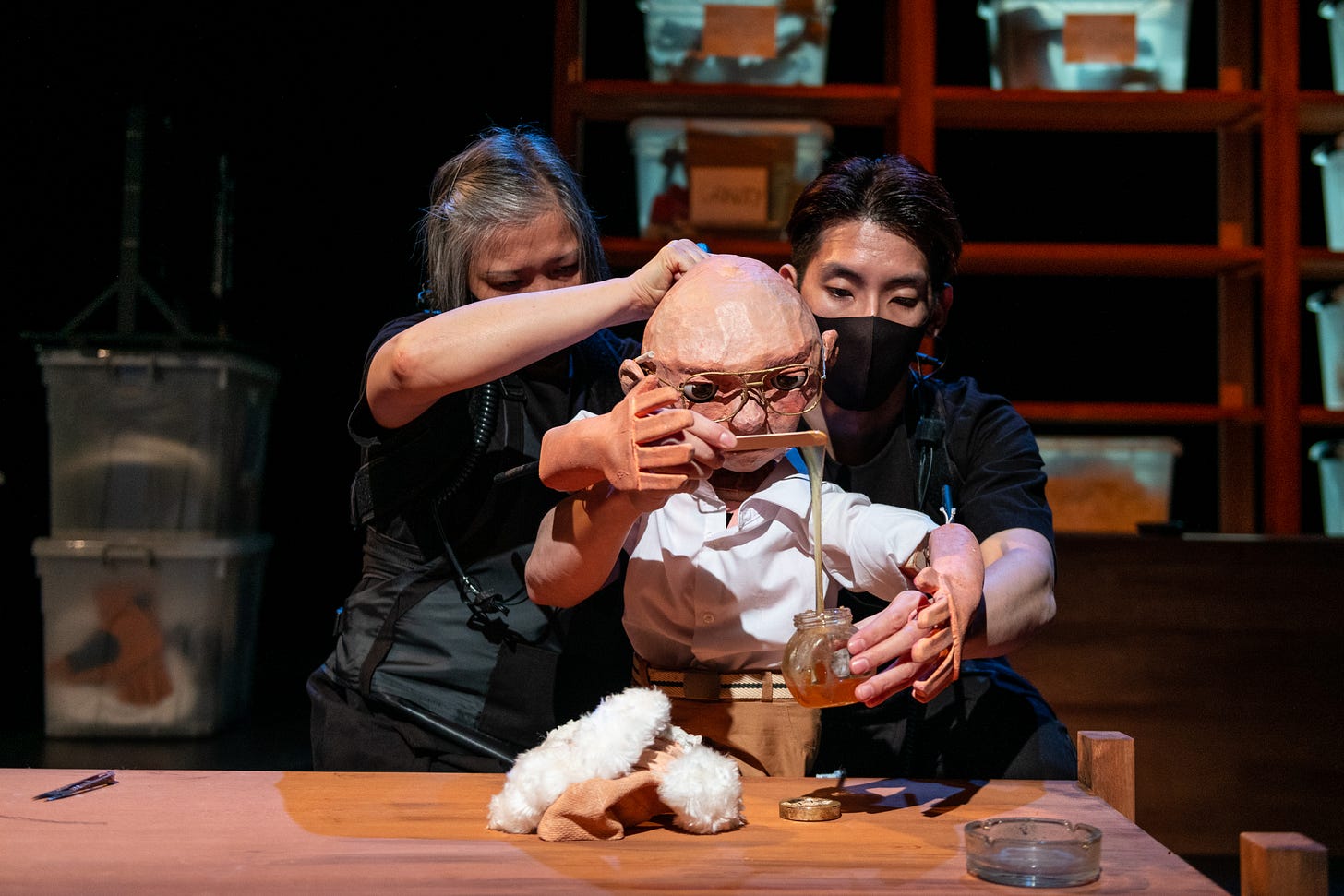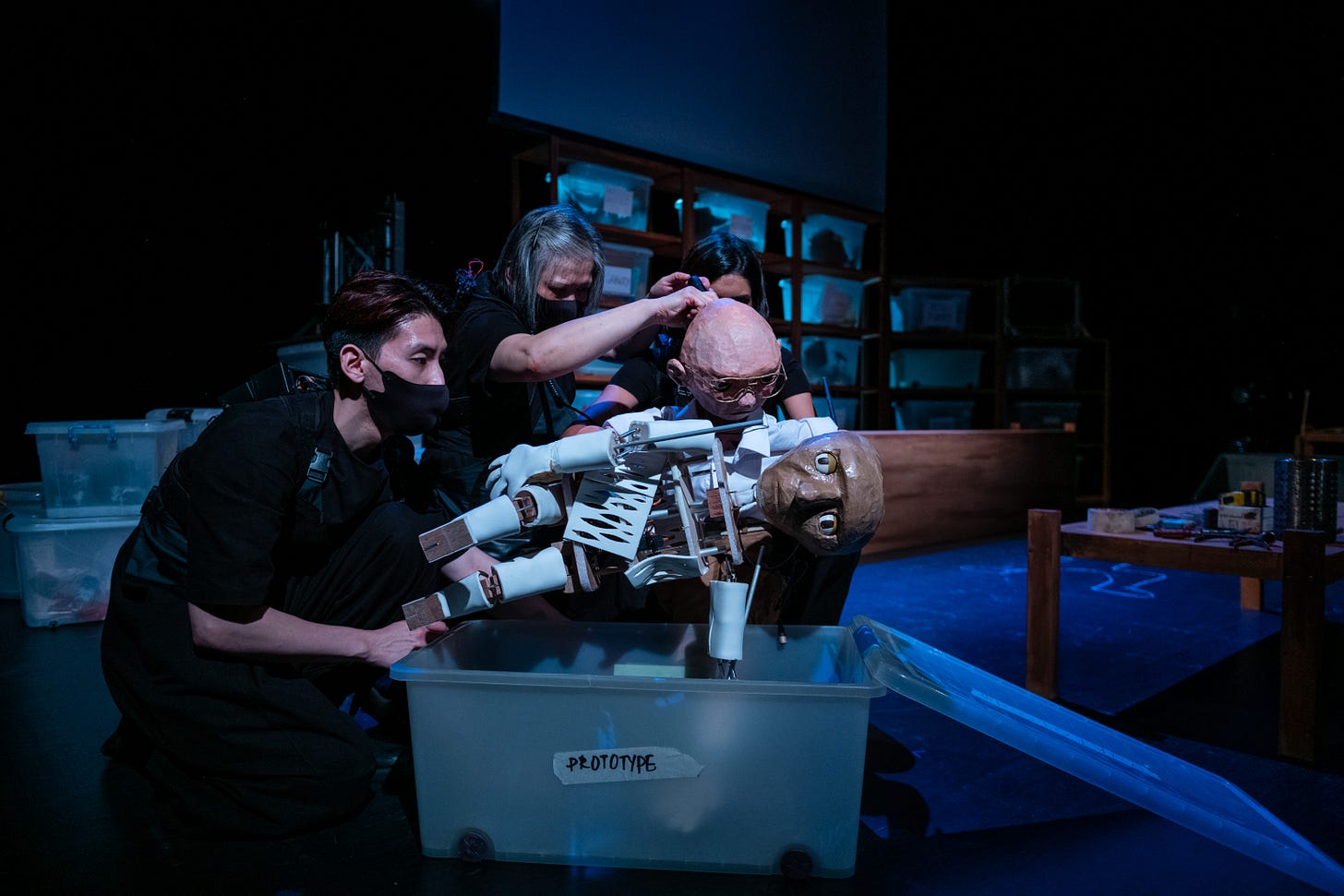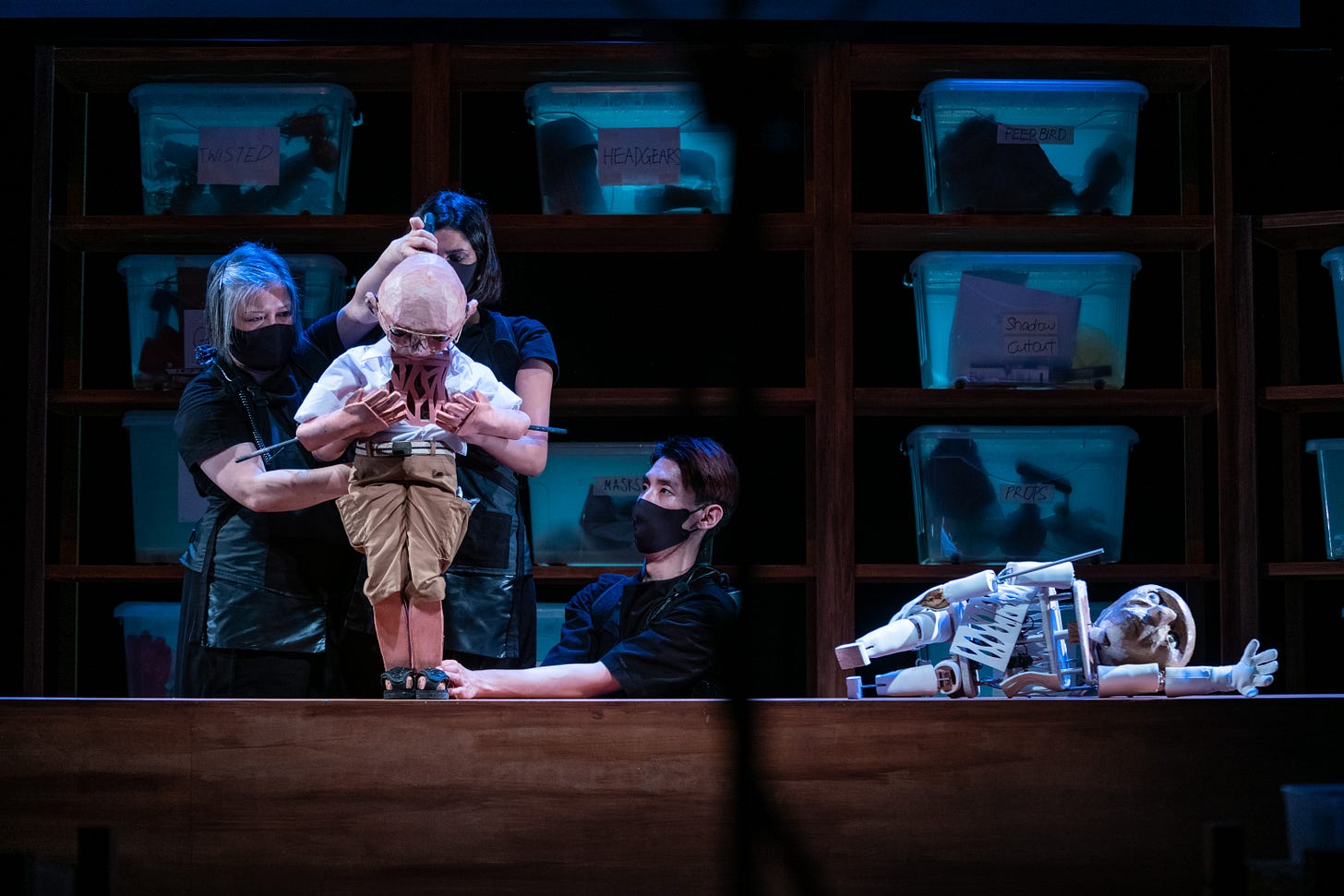"Little Mournings" – The Finger Players
A puppet becomes its own maker in this moving finale to the inaugural Maker's Project
[Dear friends, welcome back to The Intimate Critic. I’m trying to make a more conscious effort to commit to the discipline of writing and responding this year, particularly as a public act. To that end (or beginning!), I’ve overhauled the “about” page for this platform, which I hope might give you a better sense of what informs my critical interventions.]
Am I a puppet dreaming I am a human, or a human dreaming I am a puppet?

Chiam wakes up. His joints ache, and he pats them down, stretching out his knees gingerly. He sits still for a moment, and then something within his chest begins to whirr and wheeze – like a faulty pacemaker, or a collapsing lung. He gazes down at his ribcage, half-shrugs, then gets to work. Maybe you’ve seen Chiam at the coffeeshop one block over, stirring his kopi-o kosong in his white short-sleeved collared shirt and khaki bermudas, those black Bata slip-ons and a crumpled box of cigarettes in his front pocket. But Chiam’s only about three feet tall, and he’s animated by a trio of masked puppeteers – Tan Beng Tian, Darren Guo and Sindhura Kalidas.
This 45-minute production about a puppet-maker going about his daily life is probably one of the most profound experiences I’ve had in the Singapore theatre this year. As I watched Beng Tian rotate Chiam’s head on its axis to peer round at the audience, or Darren slip his fingers and palms beneath Chiam’s stiff wooden puppet hands to do a spot of delicate sewing, or Sindhu ease Chiam’s tiny feet up a flight of invisible stairs, I realised I was crying. I watched Little Mournings in a month of mourning. Often I find that my grief has been manipulated by puppeteer-forces I cannot see: the protracted global crisis of the pandemic; the announcement of The Substation’s closure; or the military junta that has violently seized Myanmar, my second home by marriage, and murdered dozens of unarmed protestors and innocent bystanders.
Chiam, our little puppet friend, isn’t animated by the process of mourning – but by the process through which he was made. And there is something to be said about recognizing how you have come to be and what it is that propels you to move, a recognition so powerful it can give a nonhuman object an almost miraculous sense of agency. So powerful that even though I can see Beng Tian, Darren and Sindhu articulating Chiam’s every limb, I can also see him exerting a force on them in return, compelling them to move with the material of his body, the angles of his joints, the way the stage lights illuminate his head.

Little Mournings is part of a culmination of the inaugural Maker’s Project, a laboratory initiative established by The Finger Players joint artistic directors Ellison Tan (who wrote the play) and Myra Loke (who directed it) in the first year of their tenure. I interviewed the both of them in 2019 just as they were just about to take up the daunting task of shepherding the beloved company through a period of challenging transitions, both artistic and financial. This response from Myra has stuck with me:
“I was blown away by how simple the set-up was. You could actually see people manipulating it, or how they did it – but it just looks very magical. […] Even after going into apprenticeship and seeing these people work, I think they are constantly making magic look like it’s very simple. I think it’s that effortlessness that is really very amazing.” (emphasis my own)
This effortlessness in Little Mournings isn’t only the result of the astonishing, fluid, dextrous work by the trio of puppeteers – but by puppet designer-maker and The Maker’s Project first artist-in-residence, Sim Xin Feng. Chiam is her creation, conjured up with the use of Arduino, an open-source electronic prototyping platform that allows users to create interactive electronic objects. Chiam relies on the puppeteers when he needs to move across the stage or carry objects – but the rise and fall of his breath, the whirr of his internal organs and the flicker of his eyes are all part of his own programming. Sometimes it is almost as if we are inside these mechanisms because of the binaural headphones clamped around our heads. We hear every drag Chiam takes on his withering cigarette, every tsk and tch and every raspy cough.
What startles me about Chiam’s story is how clearly it conveys not only the creative process, but also how difficult it is to describe the mechanics of this creative process to others. As Chiam tinkers with his objects and trouble-shoots puppet devices for the stage, we get to watch tiny snippets of some of The Finger Players’ most iconic plays: a scene from Poop! (2010) where a leaf magically drifts and swoops across the stage; a rolling shadow screen where intricate cut-outs of buildings or other landscapes are projected onto the stage as a moving backdrop – a device used in performances such as The Spirits Play (2015) and Framed, by Adolf (2018). The Finger Players are essentially placing the secrets to their stagecraft on stage – and yet the magic holds. It is the magic of the moment before an idea and the moment after. What strange confluence of events leads to that cracking open of an idea in one’s head? Is it the texture of a material that bends your memory back to a previous experiment? Is it that cigarette you shared with a friend while taking a break from an intractable problem? Is it the four days you’ve spent carrying this knot in the back of your mind, teasing it apart as you sleep?

There are two things I want to spend some time with in this response to Little Mournings – ‘knowledge’ and ‘use’.
“All knowledge is personal” — paraphrased with apologies to Michael Polanyi
Chiam’s journey makes me think about philosopher Michael Polanyi’s treatise on Personal Knowledge (1958/1962). Polanyi argued that what we consider ‘factual’ or ‘objective’ knowledge is in fact shaped by our own presence in the act of knowing something. That is, we don’t stand apart from the object of our knowledge, but participate personally in the ‘knowing’ of it. This can also make it difficult to describe how it is we know something, particularly when it comes to communicating a skill we are really good at and can do without thinking. This specific kind of knowledge is what Polanyi refers to as ‘tacit knowledge’.
Tacit knowledge isn’t the kind of knowledge we glean from textbooks or lectures. It’s also difficult to transmit to another person. For example, I can describe how I swim when I’m talking to you, or I can try to capture the act of swimming in writing – but that isn’t going to help you learn how to swim. You’ll need to get into the water and swim on your own. Xin Feng, Beng Tian, Darren and Sindhu might be able to describe to you how they manipulate Chiam as a puppet, how they synchronize their breaths or their gestures in a certain way, how many seconds they count out for a certain action. But there are so many tiny things about the way they move together with Chiam that will be impossible to explain, describe or convey – things that occur within their bodies, specific muscle groups and embodied rhythms, certain sonic or lighting cues they don’t even realise they’re paying attention to – oceans of knowledge that puppeteers, puppet designers, puppet makers and The Finger Players as a company have shored up through the years.
Polanyi looks specifically at the master-apprentice relationship and makes some sweeping (and problematic) observations about tradition, uncritical imitation and submission to authority that scholars of postcolonial Southeast Asia (such as Matthew Isaac Cohen) would very quickly debunk. I think a more thoughtful and beautiful way to look at these inheritances of craft and movement might be found in Diana Taylor’s The Archive and the Repertoire (2003), where she examines how “performance functions as vital acts of transfer, transmitting social knowledge, memory, and a sense of identity through reiterated... behaviour”. How does the memory of one body find new life in another? I felt a quiet awe watching Beng Tian, the co-founder of The Finger Players and its former artistic director, move alongside a younger generation of practitioners: shoulder to shoulder, elbow to elbow; breathing in, breathing out.
“What’s the use of use?” — Sara Ahmed
[Spoiler alert: I’m going to talk a lot about the final act of Little Mournings.]
What happens when an object has lost its use – or realises its function can be replicated, and knows it can be replaced? Sara Ahmed, who’s one of my favourite theorists, goes on this whirlwind journey on the “uses of use” in her latest book, What’s the Use? On the Uses of Use (2019). It’s so brilliant and I really recommend you read it if you can. She meditates on the difference between “use” and “function”, and how we may use things in unexpected ways. That things may be “useful” or “in use”, but can also slip “out of use” – and here she offers us the beautiful image of a postbox with a handwritten post-it on it stating: “Birds Nesting. Please do not use this Box. Many thanks.” The postbox isn’t serving its original function, but its being “out-of-use” doesn’t mean it isn’t “useful”. Often I think the state and artists in Singapore can’t agree on the usefulness of a thing or a space. That the state may see an “unused” postbox and believe a place should be re-placed, not realising that the postbox is “in use” as an incubator for a tiny cradle of life, life that is fragile or overlooked and needs to be attended to, or left alone to grow. Ahmed writes:
Perhaps use instructions are only necessary because they can be refused. Indeed, one might think of how the postbox can become a nest only by creating a queer door: the birds turn an opening into a door, that is, a way of entering the box. A queer door can be the effect of unexpected arrivals: openings intended for some things to pass through can end up providing an access point for others. (Ahmed 2019: 203, emphasis my own)
But of course an object and a place can also ‘die’, or choose its own death. Chiam’s figured out how to best manipulate a leaf, but he’s also gotten stuck on that rolling shadow screen and left that project with regret. And now he opens his final box on stage, a big plastic box larger than he is with the label “prototype” pasted on its side. He pulls back, startled. Then from within the box, and with the help of his three puppeteers, he lifts what almost looks like a puppet cadaver from within. It’s his uncanny doppelgänger, sharing the same skeleton but a different face, a face without skin.
Chiam lays his doppelgänger on his work bench, on its side. As he reaches up his own arm, patting and stroking it, he realises he’s in fact touching Darren’s arm, and Darren nods quietly at him in response. He turns his head, and there’s Beng Tian and Sindhu, who do the same. Chiam pauses, almost as if he’s taking all this in, this new inexplicable knowledge about his puppet self, his object identity, his usefulness, his weariness. Then he gazes down at his chest and slowly unbuttons his cotton shirt, revealing the delicate skeletal features of his automaton self below. We see the mechanism within his chest rise and fall, shudder and shake. There’s a vulnerability to this disrobing that almost makes me want to look away. A puppet, unabashedly naked onstage. All throughout Little Mournings, its creators and makers have been deliberate about revealing both the durability and fragility of objects and processes, and I wanted to circle back to what Ahmed writes so beautifully about her in text:
Perhaps what we create is fragile because we need it to survive. Attending to the uses of use has led me to reflect more about what is necessary, on need as politics. When a world has been assembled around your needs—when you are given what you need to live, to move on, to get on—need does not need to matter. If you have to work to have what you need, need matters. (Ahmed 2019: 221)
Chiam chooses his path; Beng Tian gently tugs a cord from the back of his head and the all-suffusive soundscape being piped through our headphones also goes dead. In the muffled silence of the room, the three puppeteers, now undertakers, lay him in his own plastic box, and heave him up onto a shelf like an urn in a columbarium. Perhaps what we create is fragile because we need it to survive. There is something so difficult to articulate about creating performance, this transformative thing that occurs for brief, intense moments in time. What “use” does it have? A postbox becomes a nest. A puppet becomes a breath. A theatre becomes divine.
Little Mournings ran from March 4-7, 2021, at the NAFA Studio Theatre. I watched the March 6, 8pm show. You can read the programme and more about The Maker’s Project here.
Other performances and processes I’m excited about watching and experiencing this month (March 2021):
Daging by Hasyimah Harith
SCOPE#10 at Dance Nucleus
The Singapore Trilogy by the Second Breakfast Company
The Last Chapter at The Substation
Model Citizens by The Necessary Stage
Resources I’m contributing to on the 2021 Spring Uprising in Myanmar:
Open-access Dropbox folder of academic resources: bit.ly/MMCoup-Resources
Up-to-date Twitter feed featuring reputable journalists and news platforms: bit.ly/mm-coup-list
People and platforms to follow: Myanm/art, Purple Feminists Group, 100 Projectors, Soup Not Coup




